After missing out on the FIFA World Cup 2022, Italy are aiming for the EURO 2024 with some fresh faces.
Firstly, Roberto Mancini departed to take over the Saudi Arabia national team, but the 2022/23 Scudetto winner Luciano Spalletti replaced him, taking charge of the Italy national team last September.
With less than a year of time to prepare for the tournament, Italy now had to fight in the group with Spain, Croatia, and Albania.
This tactical analysis is a scout report of how Italy set up their tactics under Spalletti.
Italy Predicted starting XI
It is not easy to predict Italy’s starting lineup because Spalletti has tried many different players and different formations in the previous national fixtures.
Obviously, some players, such as Inter Milan stars — Nicolò Barella and Federico Dimarco, must be a vital part of the team; Arsenal holding midfielder Jorginho was also quite likely to be the heart of the team.
Then, there are many parts they have options to change, which we will explain here.
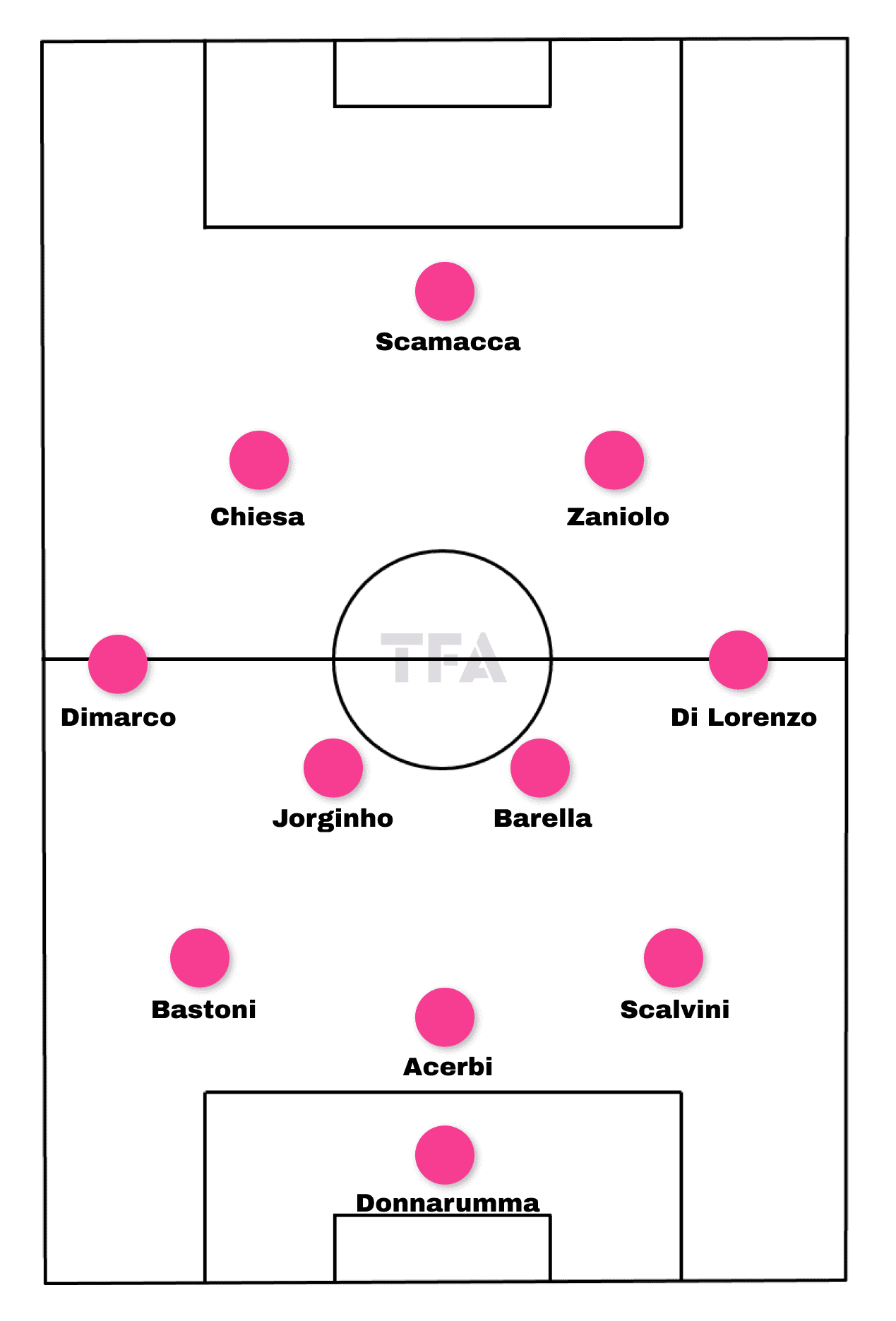
Although we predict Italy would play in a 3-4-3 formation, they could also line up in a 3-5-2, a 4-2-3-1, or even a 4-3-3 if they wish to change.
Also, under Spalletti’s relational playing style, the numbers are not so important.
If Spalletti wants three midfielders in some matches, then he would not go for the 3-4-3, so he could place Davide Frattesi or Bryan Cristante in the starting XI.
In the goalkeeper’s spot, PSG player Gianluigi Donnarumma should be a no-brainer, even if he is not very good at his feet.
If they go for a back three in the backline, they should get Francesco Acerbi in the centre, as the veteran who adds experience and communication to the side.
Then, he could partner his club teammate — Alessandro Bastoni — who had a good left foot and played decently in recent years.
While Matteo Darmian could also play right centre-back, we hinted Giorgio Scalvini could also start to add some mobility and runs from deep to the team.
He is also good at marking the opponent so that it would fit Italy’s zonal man-man system.
As suggested, the Jorginho and Barella partnership should be unshakable in the middle of the park.
On the flank, while Dimarco has no major challengers on the left, we go for Giovanni Di Lorenzo ahead of Raoul Bellanova, as he and Spalletti know each other really well.
Tactically, Di Lorenzo could also add flexibility to how the team plays, just like an extended arm of Spalletti himself on the pitch.
We’ve tipped Federico Chiesa and Nicolò Zaniolo as the starting wingers and Gianluca Scammaca as the starting striker.
These could also be changed because there were excellent options in the squad, depending on what the game context requires.
For example, Bologna winger Riccardo Orsolini came into the tournament with quite good form, and he could also earn a starting spot.
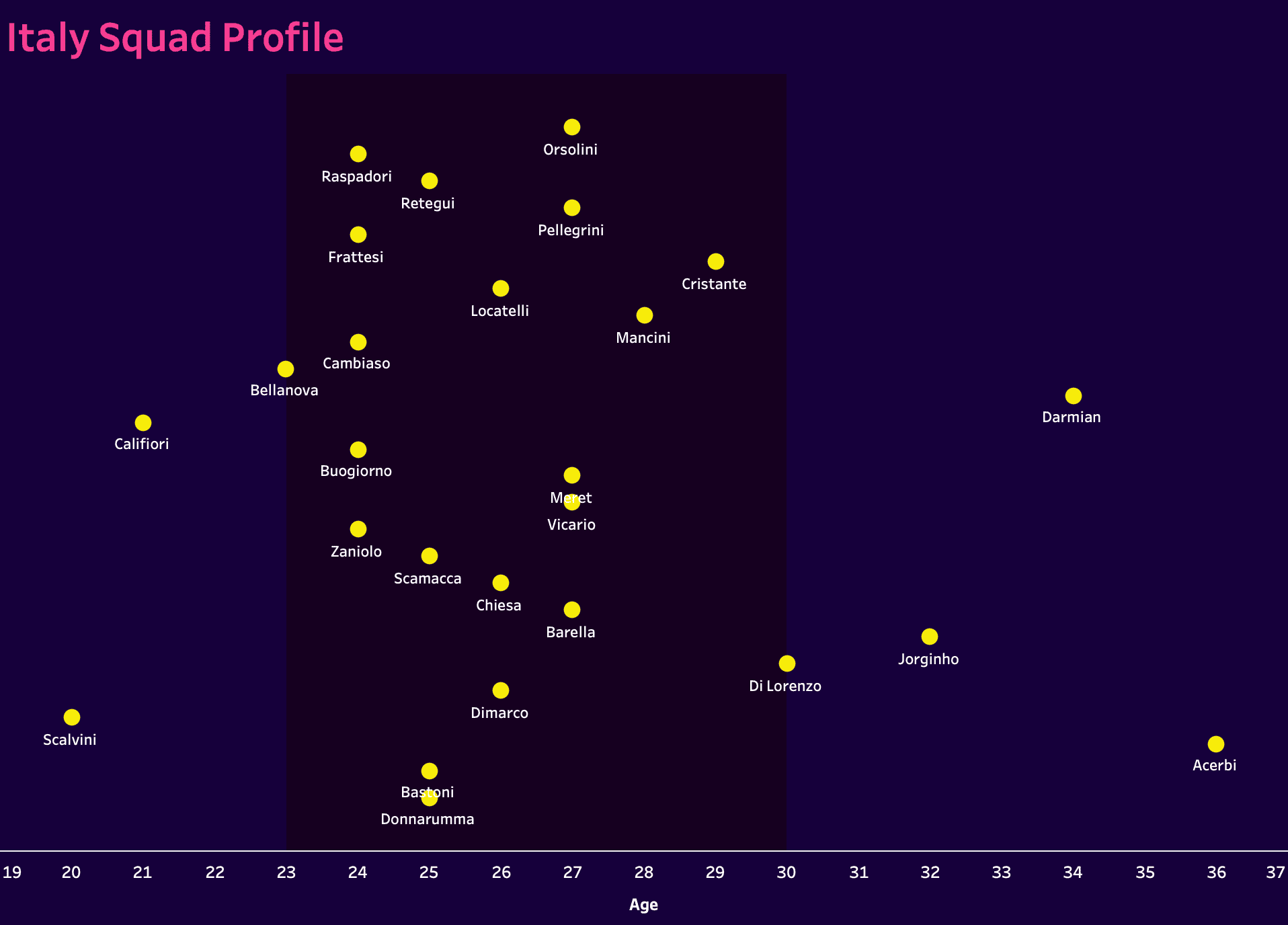
Maybe surprisingly, Italy have a lot of players at their peak — only five of whom were out of our shaded area.
The older players, such as Jorginho and Acerbi, had already won the EURO 2020, and they have the experience and leadership that could help the team.
While Scalvini and Riccardo Califiori are quite young, they add fresh options in the defence.
The core players — Dimarco, Barella, Scammaca, and Bastoni are all at their peak age and could be an advantage to Italy.
Italy Attacking phase
Offensively, Italy are no longer the positional team they were when they won EURO 2020.
Many things have changed since then, and Spalletti has tried to instil his way of playing into the team.
Now, they have better fluidity, and the players have more freedom to express themselves instead of following a clear division of roles and attacking fixed spaces with pre-designed patterns.
We will explain more in this analysis.
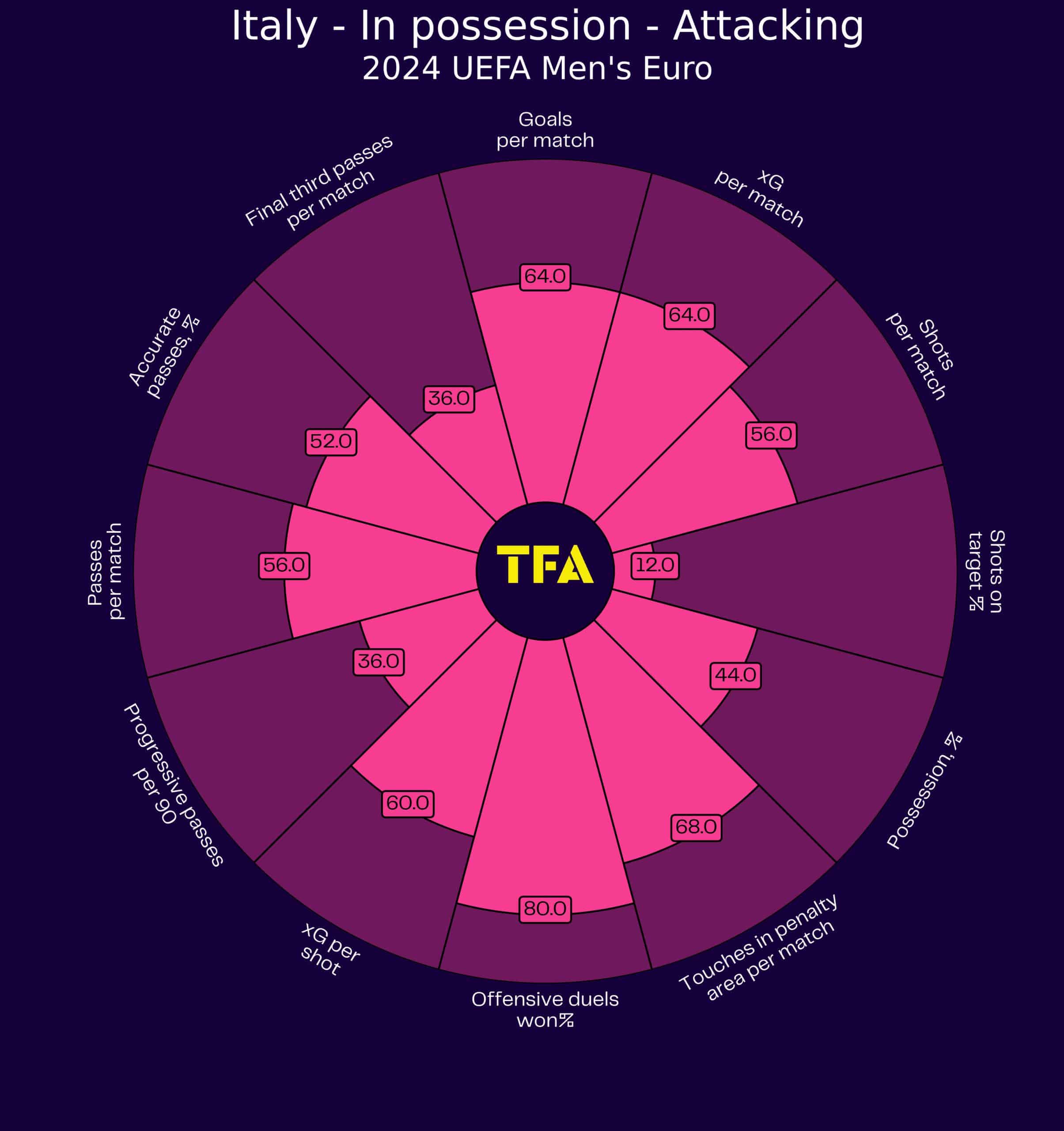
We can already have a good picture of Italy’s playing style with this chart.
They want to dominate the game, but the stats suggest otherwise, as their percentile of final third passes per match ranked 36.0.
All the metrics above have suggested they had some above-average numbers, such as an 80 percentile rank at offensive duels won % while having a 68.5 percentile rank for touches in penalty area per match.
With a 64.0 percentile in xG per match, they could create more chances, while their shots per match percentile at 56.0 and goals per match percentile at 64.0 also suggested they have room for improvement in the offensive part.
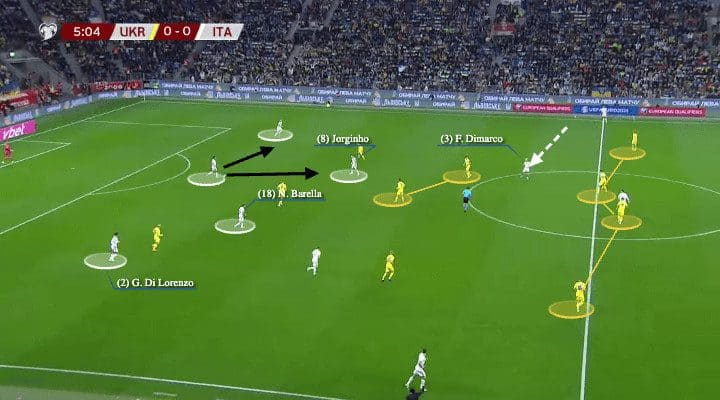
But Italy are an interesting team tactically.
A relational team gives players more freedom, but they still have a general structure.
They liked to build with 3+2, or more precisely, a 3+1+1, as Jorginho was quite fixed in the base, and Barella could roam and drop down to support when the team needed him.
For example, if the oppponents played in a 4-2-3-1 and used the attacking midfielder to mark Jorginho, then Italy could use Barella as a solution to play out.
Regardless of how Italy setup their formation on paper, it seems like Spalletti still prefers a three at the back in the build-up.
Before, it was Di Lorenzo who played as a false centre-back.
We will see how it goes in the tournament, but this role can also have the freedom to make runs forward.
The strength of Italy is shown in the above image.
Dimarco is almost like a joker card of the team when he roams freely as he did in Inter.
This could surprise the opponent and create advantages to help the team build-up.
For example, here, Acerbi had both Jorginho and Barella in support in the build-up.
Also, Dimarco, moving inside, dragged away the Ukrainian midfielders so that Jorginho could receive without an opponent at his back.
However, this scenario would not be a constant picture of Italy’s build-up, as it emerged from the player’s interpretation — they could do something else, and it became another structure in other situations.
This was what made them difficult to defend against.
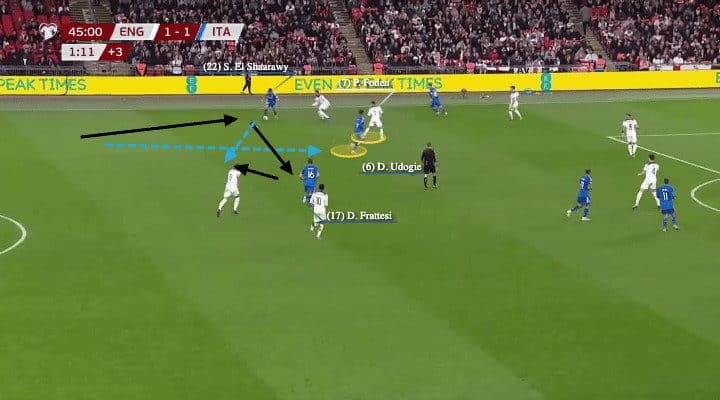
In the second image, we show their general features and how they progressed in a very relational way.
Italy relied a lot on pass-and-move and diagonal balls.
Many Italian players are good at this kind of play, such as Dimarco and Bastoni, who both played in this way at Inter.
Also, in the match against England, Tottenham Hotspur player Destiny Udogie also did a lot of pass-and-move, which resulted in the first goal.
In this example, when Udogie made the run forward after his pass to the outside, he brought away the marker, Phil Foden, to unmask the passing lane to Frattesi.
Then Stephan El Shaarawy can combine with Frattesi again with a pass-and-move combo.
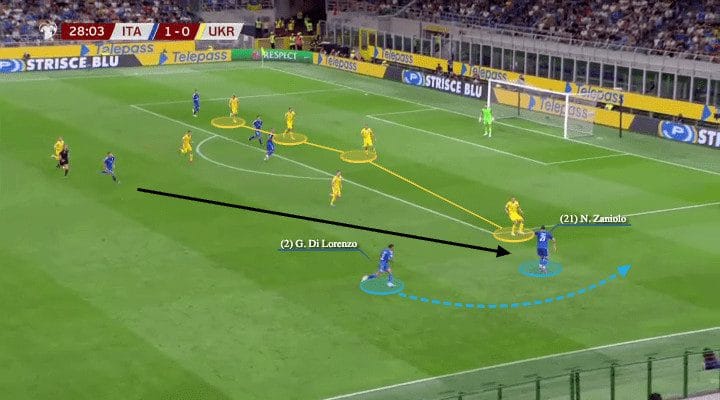
In the final phase, it depended on how Italy wanted to attack the opponent; they had different types of players.
For example, Chiesa and Orsolini could inject 1v1 quality to challenge the wide defenders so they could attack from the side.
Scammaca allowed them to play more direct and attack with crosses.
Especially on the right side, Di Lorenzo was flexible at making runs from both inside and outside.
Sometimes, he started in the centre of the pitch, then he made an underlap, but here, he supported Zaniolo with an overlap to create the 2v1.
So Italy could attack by crosses after releasing the runner, or the ball holder could just use his quality to cut in, as Zaniolo did.
Italy Defensive phase
Defensively, Italy might have some concerns despite this traditionally being their strength.
It was no longer the same.
But they have evolved and got quite a good way of pressing the opponent; in the previous games under Spalletti, they scored some pressing goals from there.
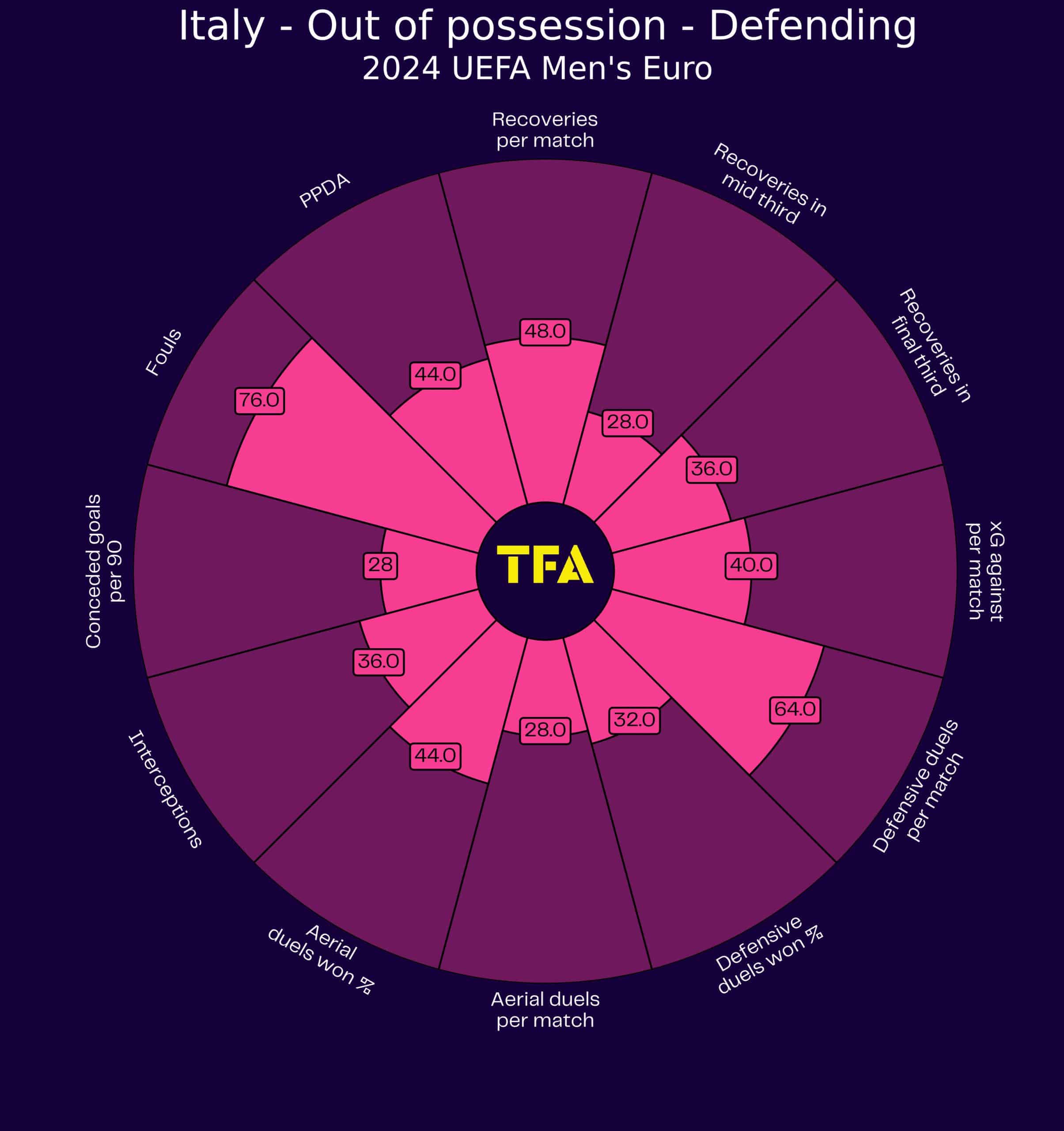
Italy were not a very strong pressing when they did not possess the ball, with an average PPDA percentile rank of 44.0; the defensive numbers were not too good in several aspects of the game.
The problem was that their low defensive duels won % per match, with a percentile ranking of 32.0.
In general, Italy had limited ability to win the ball back in both high areas and around their third, as their recoveries in the final third were only at 28.0, and recoveries per match percentile were also not impressive at 48.0.
When it comes to preventing the opponent from generating goal chances, Italy had an okay percentile ranking at 40.0 xG against per match.
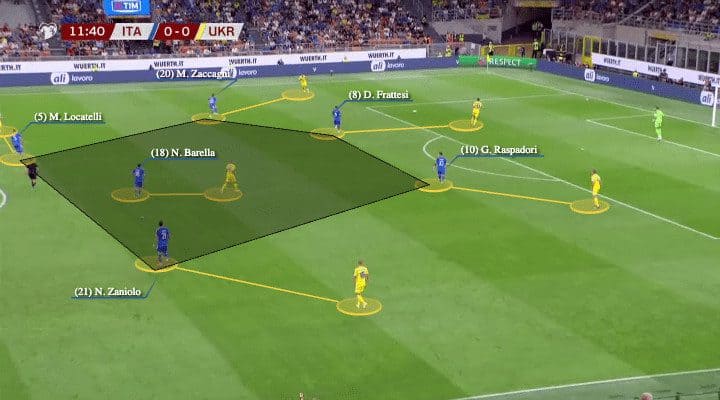
Italy are no longer a team that only defends space.
Instead, they are pressing in a zonal man-man structure if they aim for a high press.
This means they mixed both concepts of zonal defending and man marking.
They defended some space, as we highlighted, protecting the centre, but they also easily identified the mark.
On most occasions, Italy pressed with a two-in-front, usually a striker with another player (winger or midfielder).
Here, it was formed by Giacomo Raspadori and Frattesi.
Although he was not a starting player at Inter, it seems Spalletti really likes Frattesi.
He was given chances to start against England and Ukraine away, and in almost all games under Spalletti, he’s had minutes on the pitch.
Italy’s general tactic is to guide the opponent to one side, with the striker starting from standing high to decide the direction of the opposition’s attack.
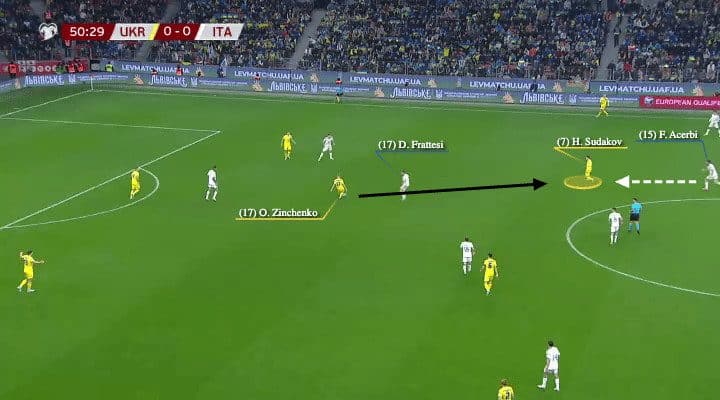
But Italy also have their problems defensively.
We suggested Italy start with a back three as Acerbi should be more comfortable stepping out in this environment.
In this example versus Ukraine, in which Italy played in a back four, Frattesi pressed Zinchenko in the midfield; they also needed a cover to press Heorhiy Sudakov to stop the line-breaking pass.
But Acerbi was quite reluctant to push in a back four so he was late to close the angle.
Jorginho can also move across to cover, but the angle is different.
So, in a back three similar to Inter, Acerbi could press with more confidence.
Against stronger opponents such as England and France, Italy would probably only want to push a little higher, and they also showed they could be patient and defend in the middle more.
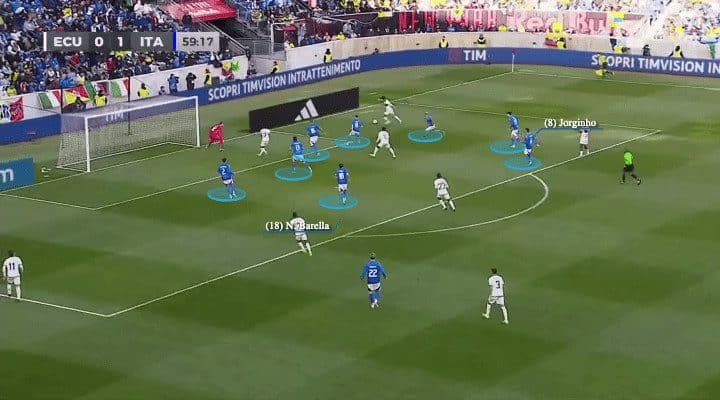
But Italy were okay when it came to defending their own box.
Although sometimes they let loose to pass and move and allow runners in behind, they had numbers in their own penalty zone.
Here, Ecuador received behind the defence, but Italy also had eight players defending their own box; the most important was to get both Barella and Jorginho back to cover the cutback or penalty spot.
If Italy could maintain this consistency in the main tournament, this might help them to achieve really good results.
Italy Transitions
In this kind of cup tournament, there will be circumstances in which Italy needs to defend low, but they should not be afraid of that because there are quality individuals who can exploit the opposition’s defence.
For example, Chiesa scored a solo goal against North Macedonia in quick transitions; he had the pace and skills to exploit these moments.
They would target space behind full-backs and wide defenders to counterattack if possible.
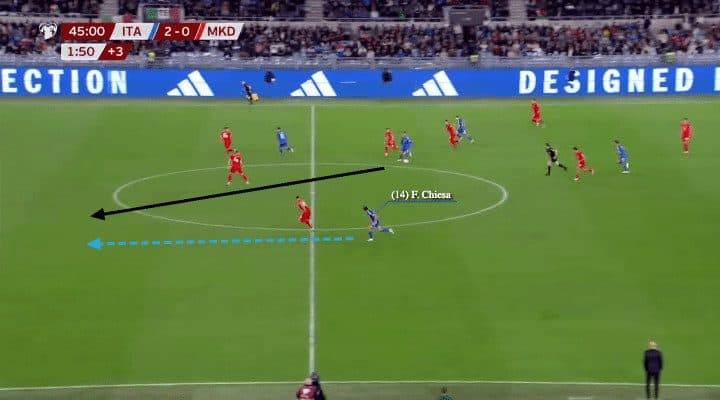
And as for the defensive transition, Italy would be fine if they shared close proximity to the ball.
The small distance between players allowed them to counterpress and win the ball back.
But one problem when Italy defended in individual situations was quite often the players challenged at the wrong angle, allowing the opponent to run free into space; if the opponent has good ball carriers, it is a weakness to exploit them, so they must make sure they can cover each other.
Italy Forwards
Scammaca had a good season at Atalanta this year.
His most recent notable performance was his game against Liverpool, in which he pressed with intensity and scored a nice goal.
With 17 goals in 40 matches, he was a quite fit option for his country.
While Scammaca was more of a traditional striker, Spalletti could also put Raspadori, who can play more like a false nine.
So Italy could take different approaches depending on the game.
Italy Midfielders
Barella was important in midfield, but we had to mention Frattesi’s performances.
When he played for the national team under Spalletti, he had 13.2 duels per 90 minutes; also, with 4.64 recoveries per 90 minutes, he might be the coach’s Swiss knife for carrying out some tactical mission.
Then, Jorginho would also be influential in organising the team together, both offensively and defensively.
Italy Defenders
Defensively, Italy have many options.
Dimarco had a decent year at Inter with six goals and eight assists in all competitions.
His 0.3 xA per 90 was really good as a wide defender.
While Bastoni had 20.52 forward passes per 90 and 7.72 passes to the final third per 90, he would be the main player to advance Italy’s attack — he shared a good collaboration with Dimarco as well.
Italy Key player
Italy had a lot of quality players; the most influential star must be Barella.
Although there were also other good players in the Italy squad, we must highlight him as the key player because he can do many things for the team.
As we explained above, Barella had an essential role in all parts of the game – he supported the defender in the build-up, ran a lot and attacked the penalty box.
Furthermore, he had a role in the high press and could counterattack the opponent.
So he is really important and irreplaceable to the team.
Italy Tournament prediction
Although they were not the favourites in 2021, Italy still won the previous EURO with some nice positional football under Mancini’s leadership.
However, the country did not build on its success.
This year, they were the reigning champions, but they were not the favourites either.
Progressing to the quarter-final could be a good result for them, but if things click, maybe they can go even further!

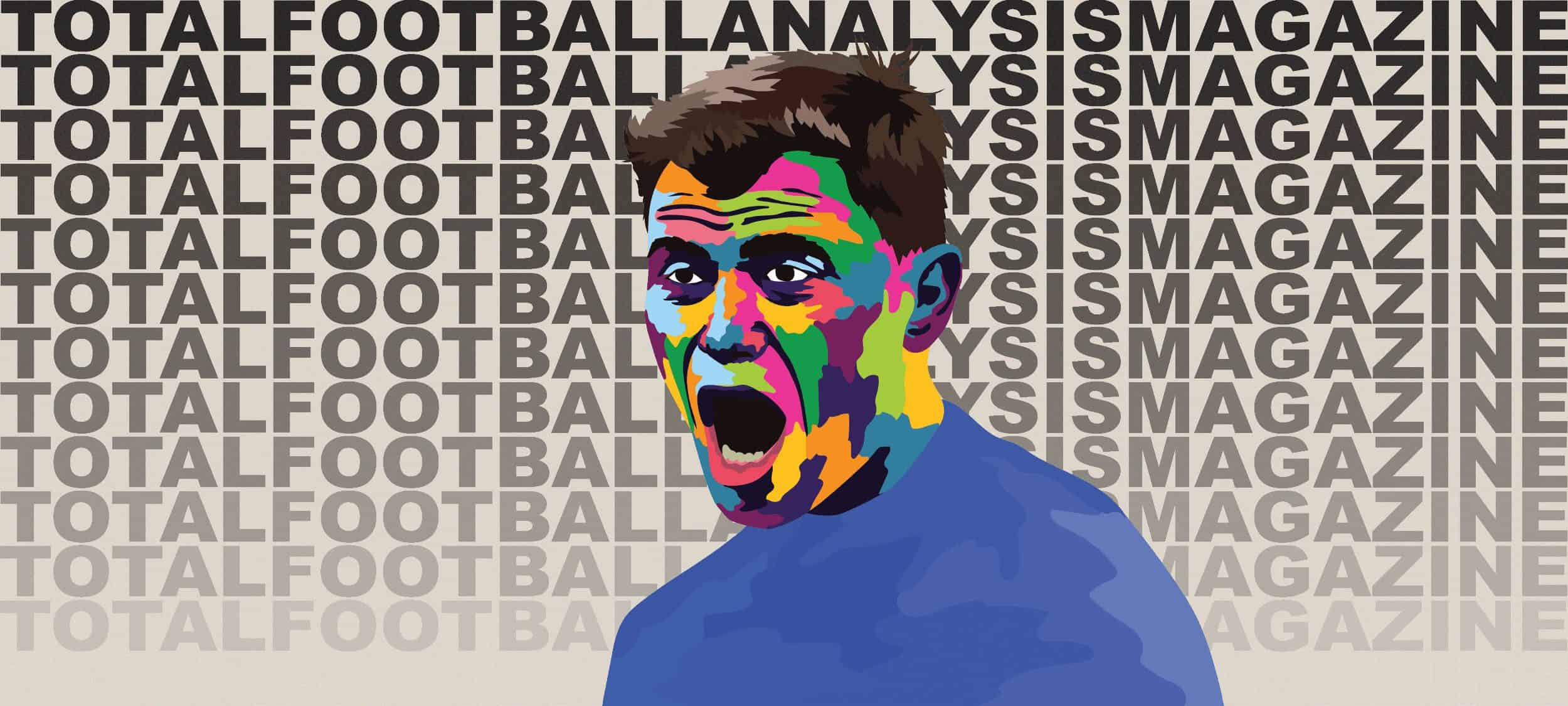



Comments